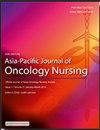Evidence summary on pain management in thoracoscopic lung cancer surgery
IF 2.4
3区 医学
Q1 NURSING
引用次数: 0
Abstract
Objective
The study aimed to systematically retrieve, evaluate and summarize evidence on perioperative pain management in adults undergoing thoracoscopic lung cancer surgery, to assist oncology nurses in improving pain assessment and management.
Methods
The research question was established using PIPOST model and a systematic search was conducted in English and Chinese databases, professional society websites and guideline platforms for literature published between January 2017 and December 2024. Included literature types comprised guidelines, systematic reviews, evidence summaries, expert consensus, and standards. After literature searching and screening in January 2025, the remaining guidelines were evaluated by four investigators, while other literature was assessed by two investigators. Evidence was then extracted and graded.
Results
Eighteen articles were included, comprising 5 systematic reviews, 3 guidelines, 2 clinical decisions, 4 evidence summaries, 3 expert consensus, and 1 standard. Twenty-five pieces of evidence across six topics were summarized, covering organizational management, high-risk patient assessment and preoperative education, pain assessment, intraoperative analgesia, multimodal pharmacological strategies, and non-pharmacological interventions.
Conclusions
This evidence summary highlights effective strategies for perioperative pain management in thoracoscopic lung cancer surgery, which could support oncology nurses in implementing comprehensive pain assessment, identifying high-risk patients, and applying diversified analgesic interventions.
胸腔镜下肺癌手术疼痛处理的证据总结
目的系统检索、评价和总结成人胸腔镜肺癌手术围手术期疼痛管理的相关证据,以帮助肿瘤科护士改进疼痛评估和管理。方法采用PIPOST模型构建研究问题,系统检索2017年1月至2024年12月间发表的中英文数据库、专业学会网站和指南平台文献。纳入的文献类型包括指南、系统综述、证据摘要、专家共识和标准。2025年1月进行文献检索和筛选后,剩余指南由4位研究者评价,其他文献由2位研究者评价。然后提取证据并进行分级。结果共纳入文献18篇,其中系统综述5篇,指南3篇,临床决策2篇,证据摘要4篇,专家共识3篇,标准1篇。总结了六个主题的25个证据,涵盖组织管理,高危患者评估和术前教育,疼痛评估,术中镇痛,多模式药物策略和非药物干预。结论总结了胸腔镜肺癌手术围手术期疼痛管理的有效策略,可支持肿瘤科护士实施全面的疼痛评估,识别高危患者,并采用多样化的镇痛干预措施。
本文章由计算机程序翻译,如有差异,请以英文原文为准。
求助全文
约1分钟内获得全文
求助全文
来源期刊

Asia-Pacific Journal of Oncology Nursing
Multiple-
CiteScore
2.80
自引率
11.10%
发文量
136
审稿时长
31 days
 求助内容:
求助内容: 应助结果提醒方式:
应助结果提醒方式:


